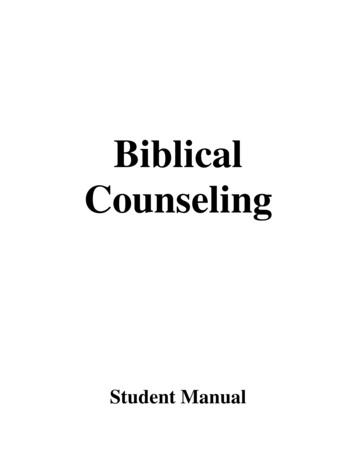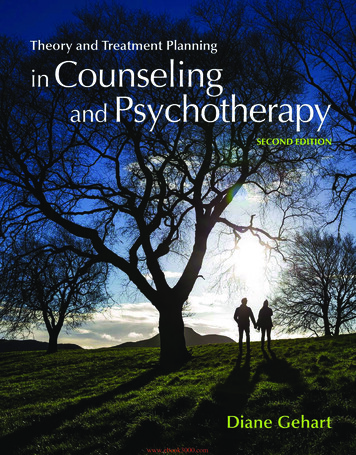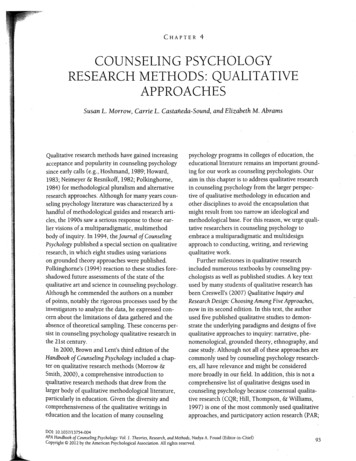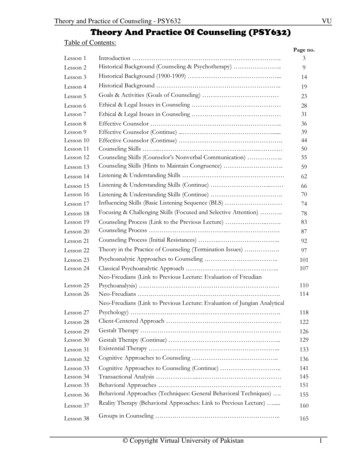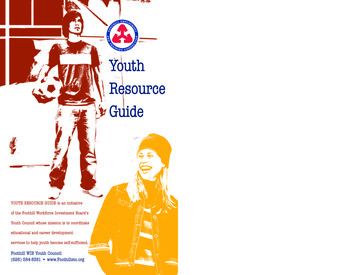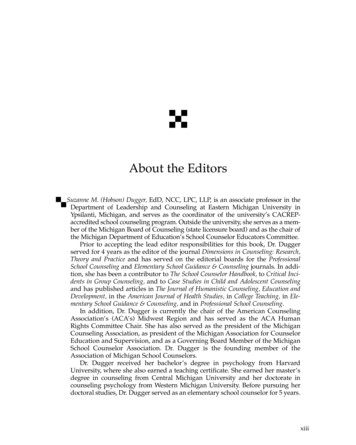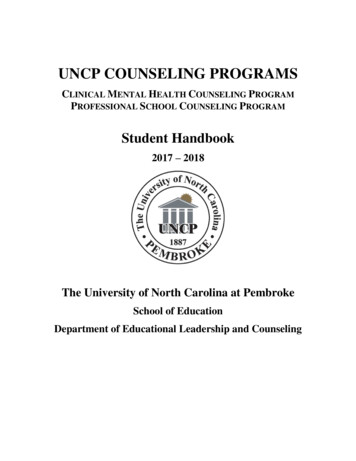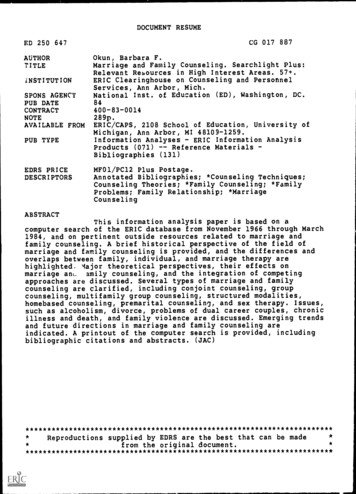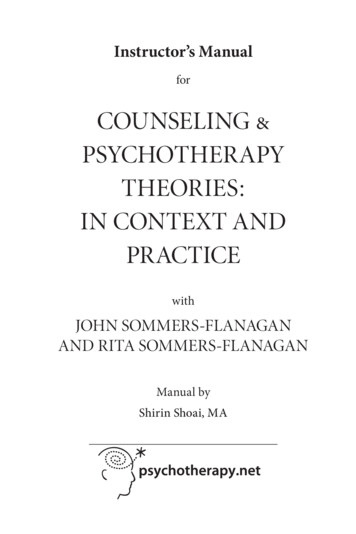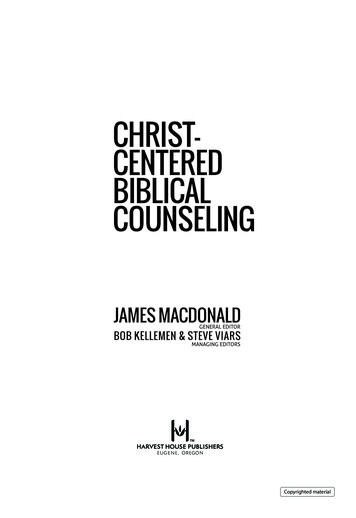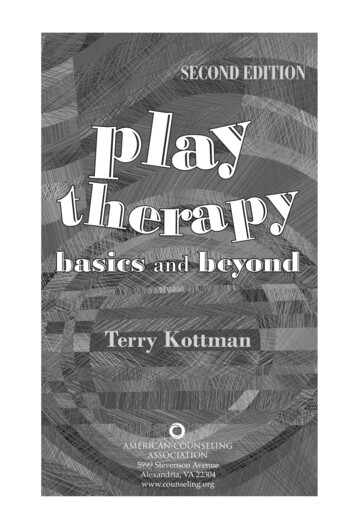
Transcription
SECOND EDITIONplaytherapybasics and beyondTerry KottmanAMERICAN COUNSELINGASSOCIATION5999 Stevenson AvenueAlexandria, VA 22304www.counseling.org
SECOND EDITIONplaytherapybasics and beyondCopyright 2011 by the American Counseling Association. All rightsreserved. Printed in the United States of America. Except as permittedunder the United States Copyright Act of 1976, no part of this publicationmay be reproduced or distributed in any form or by any means, orstored in a database or retrieval system, without the written permissionof the publisher.10987654321AMERICAN COUNSELING ASSOCIATION5999 Stevenson AvenueAlexandria, VA 22304DIRECTOR OF PUBLICATIONS Carolyn C. BakerPRODUCTION MANAGER Bonny E. GastonEDITORIAL ASSISTANT Catherine A. BrumleyCOPY EDITOR Elaine DunnCover and text design by Bonny E. GastonLIBRARY OF CONGRESS CATALOGING-IN-PUBLICATION DATAKottman, Terry.Play therapy : basics and beyond/Terry Kottman.—2nd ed.p. cm.Includes bibliographical references and index.ISBN 978-1-55620-305-3 (alk. paper)1. Play therapy. 2. Psychotherapy. I. Title.RJ505.P6K643 2011616.89’1653—dc222010027176
dedicationFor Jacob, who teaches me what being a kid (and now, a teen)is all about—every day—whether I want to learn or not. For Rick, who is there with me learning—there for the good,the bad, and the ugly.iii
table of contentsAcknowledgmentsPrefaceAbout the AuthorPART 1xixiiixviibasic conceptsChapter 1Introduction to Play TherapyTherapeutic Powers of PlayPersonal Qualities of a Play TherapistAppropriate Clients for Play TherapyParadigm Shift From Talk to PlayPlay Therapy Dimensions ModelPractice ExercisesQuestions to PonderChapter 2History of Play TherapyPsychoanalytic/Psychodynamic Play TherapyStructured Play TherapyRelationship Play TherapyNondirective, Child-Centered Play TherapyLimit-Setting TherapyTheories Designed for Working With ChildrenWho Have Attachment IssuesPlay Therapy Approaches Based on TheoriesOriginally Developed for Working With AdultsPlay Therapy Approaches Based on IntegratingSeveral Different Theories34151522232626292930313233333436v
Table of ContentsShort-Term, Time-Limited Play TherapyPrescriptive Play TherapyQuestions to PonderChapter 3Theoretical Approaches to Play TherapyPART 2Adlerian Play TherapyChild-Centered Play TherapyCognitive–Behavioral Play TherapyEcosystemic Play TherapyGestalt Play TherapyJungian Analytical Play TherapyPsychodynamic Play TherapyTheraplayPrescriptive Play TherapyQuestions to Ponder3738384142475256626771757982basic skillsChapter 4Logistical Aspects of Play TherapySetting Up a Space for TherapyChoosing and Arranging ToysExplaining the Play Therapy ProcessThe Initial SessionEnding a SessionAssessing Patterns in the Child’s PlayWriting Session ReportsTerminationQuestions to PonderChapter 5TrackingHow to TrackMonitoring Children’s Reactions to TrackingApplications in Different Theoretical OrientationsExamples of TrackingPractice ExercisesQuestions to PonderChapter 6Restating ContentHow to Restate ContentFocus of RestatementsInfluencing Children by UsingRestatement of 17118121121122122
Table of ContentsMonitoring Children’s Reactions toRestating ContentApplications in Different Theoretical OrientationsExamples of Restating ContentPractice ExercisesQuestions to PonderChapter 7Reflecting FeelingsHow to Reflect FeelingsWhat to ReflectMonitoring Children’s Responses toReflection of FeelingsExpanding Feeling Concepts and VocabularyApplications in Different Theoretical OrientationsExamples of Reflecting FeelingsPractice ExercisesQuestions to PonderChapter 8Setting LimitsWhat to LimitWhen to LimitPractical Considerations in LimitingStyles of LimitingExamples of Limit SettingPractice ExercisesQuestions to PonderChapter 9Returning Responsibility to the ChildWhen to Return Responsibility to the ChildHow to Return Responsibility to the ChildWhen Not to Return Responsibilityto the ChildApplications in Different Theoretical OrientationsExamples of Returning Responsibilityto the ChildPractice ExercisesQuestions to PonderChapter 10Dealing With QuestionsThe Nature of Children’s Questionsin Play TherapyTypes of Responses (With Examples)Practice ExercisesQuestions to 77180187188vii
Table of ContentsChapter 11Integration of Basic Skills:The Art of Play TherapyDeciding When to Use a SkillIntegrating and Infusing Skills (With Examples)Practice ExercisesQuestions to Ponder189189193198200PART 3advanced skillsand conceptsChapter 12Recognizing and CommunicatingThrough MetaphorsRecognizing MetaphorsUnderstanding the Meaning of Metaphorsin Play TherapyUsing the Child’s Metaphor toCommunicate With the ChildMonitoring the Child’s Reaction toUsing the MetaphorExamples of Using the Child’s Metaphorto CommunicatePractice ExercisesQuestions to PonderChapter 13Advanced Play Therapy SkillsMetacommunicationTherapeutic MetaphorsMutual StorytellingRole-Playing/Engaging in Play With the ChildPractice ExercisesQuestions to PonderChapter 14Working With Parents and TeachersviiiFilial TherapyKinder TrainingParent–Child Interaction TherapyAdlerian Parent and Teacher ConsultationPersonal ApplicationPractice ExercisesQuestions to 3245248250251253255256257
Table of ContentsChapter 15Professional Issues in Play TherapyResearch Support for Play TherapyLegal and Ethical IssuesCultural Awareness and SensitivityInclusion of Aggressive Toys in the PlayroomPublic Awareness of Play Therapy andProfessional Identity of Play TherapistsAdvice to Beginning Play TherapistsPractice ExercisesQuestions to Ponder259259264267271273274277279Appendix ASelected References on DifferentTheoretical Orientations to Play Therapy281Appendix BAn Explanation of Play Therapy:Handout for Parents289Appendix CSelected Resources Related to Play TherapyWith Culturally Diverse ChildrenAppendix D291Play Therapy ix
acknowledgmentsAs usual, I want to thank my husband, Rick, who is my first and last reader—gentle, but firm—telling me what makes sense and what doesn’t, what canstay and what needs to go. I am also grateful to the expert play therapistswho were willing to fill out the survey I sent to representative play therapistsfor each of the theoretical orientations I have covered in this book:Felicia Carroll, MEd, MA, Licensed Marriage and Family Therapist,Registered Play Therapist-Supervisor; founder-director of the WestCoast Institute for Gestalt Play Therapy; private practice in Solvang,CA—Gestalt play therapyAthena Drewes, PsyD, Registered Play Therapist-Supervisor; director ofclinical training and American Psychological Association–accreditedinternship, Astor Services for Children and Families, Poughkeepsie,NY—prescriptive-integrative play therapyParis Goodyear-Brown, MSSW, LCSW, Registered Play TherapistSupervisor; owner, Paris and Me Counseling for Kids, Antioch, TN—prescriptive play therapyEric Green, PhD, Registered Play Therapist-Supervisor; LPC, LMFT,assistant professor and clinical director, Department of Counselingand Human Services, University of North Texas at Dallas, Dallas,TX—Jungian analytical play therapyDana Holtz, MS, NCC, LPC, Registered Play Therapist-Supervisor,Certified Juvenile Treatment Specialist; private practice, high schoolcounselor, Tucson, AZ—Adlerian play therapySusan Knell, PhD, clinical psychologist; Spectrum Psychological Associates, Mayfield Village, OH—cognitive–behavioral play therapyJohn Paul “JP” Lilly, MS, LCSW, Registered Play Therapist-Supervisor;owner, Sierra Counseling Associates, Inc., Provo, UT—Jungian analytical play therapyEvangeline Munns, PhD, CPsych, Registered Play Therapist-Supervisor,Theraplay Institute supervisor, Canadian Association for Child PlayTherapists supervisor—Theraplayxi
AcknowledgmentsKevin O’Connor, PhD, Registered Play Therapist-Supervisor; DistinguishedProfessor, Clinical PsyD Program-Fresno/Sacramento; coordinator,Ecosystemic Clinical Psychology Emphasis; senior research scholar,Rockway Institute, Alliant International University, California Schoolof Professional Psychology, Fresno, CA—ecosystemic play therapyDee Ray, PhD, Registered Play Therapist-Supervisor; Associate Professor, Department of Counseling and Higher Education; director, Childand Family Resource Clinic, University of North Texas—child-centeredplay therapyCharles Schaefer, PhD, Registered Play Therapist-Supervisor; Professor Emeritus of Psychology, Fairleigh Dickinson University, Teaneck,NJ—prescriptive play therapyLynn Stadler, MA, Licensed Marriage Family Therapist, Santa Barbara,CA—Gestalt play therapyAideen Taylor de Faoite, MA in play therapy, PGCE DPP (EducationalPsychology); private practice as a play therapist and school psychologist, Child Psychology West, Galway, Ireland—narrative play therapyTimothy Tisdell, PsyD, clinical psychologist; private practice, VillageCounseling and Assessment Center, Oakland, CA—psychodynamicplay therapyRisë VanFleet, PhD, Registered Play Therapist-Supervisor; director of theFamily Enhancement and Play Therapy Center; director, Playful PoochProgram, Boiling Springs, PA—child-centered play therapy xii
prefaceOver the past 20 years, the demand for mental health professionals and schoolcounselors who have training and expertise in using play as a therapeuticmodality in working with children has increased tremendously. There hasbeen a commensurate demand for trained play therapists. I designed the firstedition of Play Therapy: Basics and Beyond to provide an introduction to thedifferent skills used in play therapy combined with an atheoretical orientationto the basic concepts involved in play therapy. It was a practical introductionto play therapy concepts and skills. I stressed the application of various playtherapy strategies across a wide range of theoretical orientations. The firstedition has been widely used to teach introductory play therapy coursesand introductory child counseling courses. I wrote this second edition inresponse to requests from colleagues for an updated version of the original.The primary intended audience for this book is students enrolled in introductory play therapy courses and introductory child counseling courses.Because the book provides information about many different theoreticalorientations, it can be helpful no matter what the theoretical orientationof the professor, the student, or the program. I also wrote this book forclinicians who would like to have more knowledge and understanding ofplay therapy but who do not have access to formal training in the field.With these two audiences in mind, I made some assumptions about thebackgrounds of those using the book as their entry to the world of playtherapy. I assumed that the reader has some basic background in counseling,psychology, social work, or some other related field—many of the terms andconcepts used in this book are borrowed from other mental health–relatedareas. Two other assumptions were that the reader has some knowledge andexposure to children and at least a sketchy understanding of child development.PLAN OF THE BOOKChapters 1 through 3 compose Part 1, Basic Concepts. In Chapter 1,“Introduction to Play Therapy,” I provide an explanation of the paradigmxiii
Prefaceshift necessary to move from talk as therapy to play as therapy, severaldefinitions and rationales for play therapy, descriptions of the therapeuticpowers of play, information about appropriate clients for play therapy,and descriptions of characteristics and experiences needed by therapistswho want to use play as a treatment modality. In Chapter 2, “History ofPlay Therapy,” the reader will learn about the evolution of play therapy.Chapter 3, “Theoretical Approaches to Play Therapy,” contains detaileddescriptions of nine selected contemporary approaches to play therapy,focusing on the theoretical constructs, the stages of play therapy, the roleof the therapist, goals of therapy, approaches to working with parents,and distinctive features of each approach.Chapters 4 through 11 compose Part 2, Basic Skills. In Chapter 4,“Logistical Aspects of Play Therapy,” the reader will learn about settingup a space for play therapy, choosing and arranging toys, explaining theplay therapy process to parents and children, handling the initial session,assessing children’s play behavior, dealing with paperwork, ending a session, and terminating the therapy process. There are several basic playtherapy skills that are used in most approaches to play therapy: (a) tracking behavior, (b) restating content, (c) reflecting feelings, (d) limiting, (e)returning responsibility to the child, and (f) dealing with questions. Theapplication of these skills varies depending on the theoretical orientationof the therapist and the stage of therapy, but at one time or another, mostplay therapists use them. In Chapters 5 through 10, I define each of theseskills, delineate the purpose for its use in the play therapy process, andexplain how the skills can be applied in various situations in play therapy.To make each of the skills more concrete and accessible to the reader, Iprovide examples of the application of the skill and invite the reader topractice the skill using exercises tailored to demonstrate various situationsin which the skills would be appropriate. At the end of each chapter, thereader can find practice exercises designed to hone the application of thetargeted skill. I believe that all play therapists need to look at their ownthoughts, feelings, attitudes, and personal issues to become truly skillfulin working with children. The “Questions to Ponder” at the end of eachchapter are my attempt to facilitate this self-examination process.In Chapter 5, “Tracking,” the reader will learn about using tracking toestablish a relationship with the child. Building rapport is also the focus inChapter 6, “Restating Content.” The reader can explore strategies for reflectingfeelings to help the child learn to understand his or her emotions in Chapter7, “Reflecting Feelings.” In Chapter 8, “Setting Limits,” I provide the readerwith several different techniques for limiting inappropriate behavior in theplayroom. In Chapter 9, “Returning Responsibility to the Child,” a rationaleand description of methods for returning responsibility to the child will helpthe reader explore this important skill. Because all children in the playroomask questions, the reader will learn how to understand possible meaningsand how to handle queries in Chapter 10, “Dealing With Questions.”In Chapter 11, “Integration of Basic Skills: The Art of Play Therapy,”I provide an explanation of and practice in methods for deciding whichxiv
Prefaceskill to use when and for integrating several different skills together tocreate a combined intervention that works more smoothly and more efficaciously than an isolated skill would. The reader will also explore the needfor blending the therapist’s personality and interactional style with playtherapy skills to present a more natural flow of interaction with the child.Chapters 12 through 15 compose Part 3, Advanced Skills and Concepts.Much of the communication that takes place in play therapy comes inthe form of metaphors. Chapter 12, “Recognizing and CommunicatingThrough Metaphors,” contains descriptions of strategies and practiceexercises for learning to understand possible meanings of children’smetaphors. The reader will also learn and practice ways to use metaphorscreated by children to facilitate communication with them in their ownnatural language. In this chapter there is also information on designingtherapeutic metaphors and other storytelling techniques that can be usedin play therapy.Chapter 13, “Advanced Play Therapy Skills,” includes informationon using metacommunication, visualization strategies, art techniques,sand tray play therapy, and role-playing/playing with children in playtherapy. In this chapter, the reader can find examples of the application ofeach of these advanced skills and exercises that provide guided practicein their use.In the years since the first edition of this book, the research in the fieldhas suggested that one of the main factors that increase the efficacy of playtherapy is working with parents. There have also been some suggestionsin the literature that consulting with teachers of children who are struggling in school can also enhance the efficacy of play therapy. Because ofthis, I have added this new chapter, “Working With Parents and Teachers” (Chapter 14). This chapter is an overview of the information available concerning filial therapy, Kinder Training, Parent–Child InteractionTherapy, and Adlerian parent and teacher consultation.Because play therapy is an emerging profession, it is essential that individuals interested in the field stay informed about professional issuesthat can have an impact on the field. To facilitate this process, in Chapter15, “Professional Issues in Play Therapy,” I include information on thefollowing issues: (a) research into the efficacy of play therapy, (b) legaland ethical issues, (c) cultural awareness and sensitivity, (d) inclusion ofaggressive toys in the playroom, and (e) public awareness of play therapyand professional identity of play therapistsBECOMING A TRAINED PLAY THERAPISTReading this book will not be sufficient to transform the reader into atrained play therapist. To become a play therapist, it is essential to thoroughly study the concepts and information in this text, explore specifictheoretical approaches in more depth, learn more about both beginningand advanced-level play therapy skills, and gain experience working withchildren using play therapy interventions under the supervision of a playxv
Prefacetherapy professional. I believe that an introductory play therapy classshould require the students to conduct multiple play therapy sessionsfor which they receive feedback from experienced play therapists beforeventuring to begin to conduct other play therapy sessions (also under thesupervision of a trained and experienced play therapy supervisor). I alsobelieve that an individual who wishes to become a play therapist mustcontinue to work on his or her own personal issues. Several organizations (e.g., Association for Play Therapy, Canadian Association for Childand Play Therapy, British Association of Play Therapy) have providedguidelines for the training and supervised clinical experience necessaryto become a trained play therapist.xvi
about the authorTerry Kottman, PhD, RPT-S, NCC, LMHC, founded The EncouragementZone, a training center for play therapists and other counselors. Beforeher “retirement,” she was a professor of counselor education at theUniversity of Northern Iowa and the University of North Texas. She is aregistered play therapist-supervisor; maintains a small private practice;and volunteers in an elementary school, working with children and schoolpersonnel. Dr. Kottman developed Adlerian play therapy, an approach tocounseling children that combines the ideas and techniques of IndividualPsychology and play therapy. She regularly presents workshops on playtherapy, activity-based counseling, counseling children, and school counseling. Dr. Kottman is the author of Partners in Play: An Adlerian Approachto Play Therapy and the first edition of Play Therapy: Basics and Beyond. Sheis the coauthor (with J. Muro) of Guidance and Counseling in the Elementaryand Middle Schools, coauthor (with J. Ashby and D. DeGraaf) of Adventuresin Guidance: How to Integrate Fun Into Your Guidance Program and ActiveInterventions for Kids and Teens: Adding Adventure and Fun to Counseling,and coeditor (with C. Schaefer) of Play Therapy in Action: A Casebook forPractitioners and (with A. Vernon) of Counseling Theories: Practical Applications with Children and Adolescents in School Settings. xvii
Cognitive–Behavioral Play Therapy 52 Ecosystemic Play Therapy 56 . assessing children’s play behavior, dealing with paperwork, ending a ses - sion, and terminating the therapy process. There are several basic play . Preface. xvi
